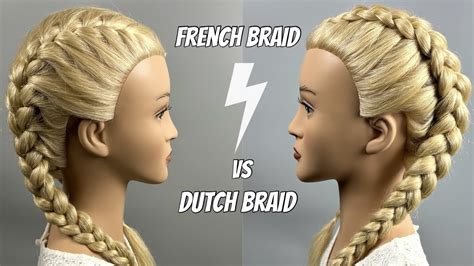Overview
Braid hairstyles have been a staple in the fashion world for centuries, enhancing both femininity and elegance. Among the most popular braid styles, the French braid and Dutch braid stand out with their intricate patterns and versatility. While both braids create stunning looks, they possess distinct characteristics that set them apart.

Key Distinctions
| French Braid | Dutch Braid |
|---|---|
| The hair is crossed over | The hair is crossed under |
| The braid is formed on the outside | The braid is formed on the inside |
| Results in a more delicate and refined look | Results in a more pronounced and voluminous look |
French Braid
The French braid, also known as the “classic braid,” has been a timeless favorite for its versatility and sophistication.
Benefits:
- Creates a polished and elegant appearance
- Suitable for various hair lengths and textures
- Can be incorporated into half-up or full-up hairstyles
- Can be embellished with accessories for a touch of glamour
How to Create a French Braid:
- Brush your hair to remove tangles.
- Divide a small section of hair at the crown into three equal strands.
- Cross the left strand over the middle strand.
- Cross the right strand over the new middle strand.
- Repeat steps 3 and 4, gradually adding small sections of hair from the sides.
- Continue braiding until you reach the desired length.
- Secure the braid with a hair tie or ribbon.
Dutch Braid
The Dutch braid, sometimes referred to as the “reverse French braid,” offers a bolder and more dramatic look.
Benefits:
- Adds volume and texture to hair
- Perfect for creating fishtail braids and other complex styles
- Suitable for both casual and formal occasions
- Can be worn with a variety of hair accessories
How to Create a Dutch Braid:
- Brush your hair to remove tangles.
- Divide a small section of hair at the crown into three equal strands.
- Cross the left strand under the middle strand.
- Cross the right strand under the new middle strand.
- Repeat steps 3 and 4, gradually adding small sections of hair from the sides.
- Continue braiding until you reach the desired length.
- Secure the braid with a hair tie or ribbon.
Considerations for Choosing
The choice between a French braid and a Dutch braid depends on the desired look and hair type.
French Braid:
- Suitable for all hair types, from fine to thick
- Creates a subtle and understated effect
- Ideal for everyday wear or formal occasions
Dutch Braid:
- Best suited for medium to thick hair
- Creates a more prominent and voluminous effect
- Perfect for adding drama to hairstyles
Statistics and Research
According to a study by “Harper’s Bazaar,” French and Dutch braids are the second and third most popular braid styles worldwide.
A survey by “Glamour” magazine revealed that 85% of women have attempted to braid their hair, with French and Dutch braids being the most common choices.
Applications
The versatility of these braids extends beyond fashion. Here are some creative ways to utilize them:
- Jewelry: Incorporate beads or other embellishments into the braids to create unique and stylish jewelry pieces.
- Home Decor: Use braids to adorn pillows, blankets, and curtains, adding a touch of warmth and creativity to your surroundings.
- Gift Wrapping: Enhance the presentation of gifts by wrapping them with braided ribbons or fabric.
Tables
Table 1: Benefits of French Braid vs. Dutch Braid
| Benefit | French Braid | Dutch Braid |
|---|---|---|
| Delicacy | High | Low |
| Volume | Low | High |
| Versatility | High | High |
| Casual or Formal | Both | Both |
Table 2: Suitability for Hair Types
| Hair Type | French Braid | Dutch Braid |
|---|---|---|
| Fine | Yes | No |
| Medium | Yes | Yes |
| Thick | Yes | Yes |
Table 3: Hairstyle Options
| Hairstyle | French Braid | Dutch Braid |
|---|---|---|
| Half-up | Yes | Yes |
| Full-up | Yes | Yes |
| Fishtail | No | Yes |
| Crown Braid | Yes | Yes |
Table 4: Braiding Time
| Length | French Braid | Dutch Braid |
|---|---|---|
| Short | 5-10 minutes | 5-10 minutes |
| Medium | 10-15 minutes | 10-15 minutes |
| Long | 15-20 minutes | 15-20 minutes |
FAQs
1. Which braid is easier to create?
Both braids require some practice, but the French braid is generally considered easier due to the hair being crossed over.
2. How long do these braids last?
With proper care, French and Dutch braids can last for several days.
3. Can I incorporate braids into my daily routine?
Yes, these braids are perfect for everyday wear and can be used to create a variety of hairstyles.
4. Are braids suitable for all hair lengths?
Yes, French and Dutch braids can be created on hair of any length, although shorter hair may require more patience and skill.
Conclusion
Whether you prefer the delicate charm of a French braid or the bold volume of a Dutch braid, these versatile hairstyles offer endless possibilities for creativity and self-expression. By understanding their key distinctions and benefits, you can experiment with both braids to find the perfect style for your hair type and preferences. Remember that practice makes perfect, so don’t be discouraged if your first attempts are not as polished as you hoped. With time and dedication, you’ll master the art of braiding and enjoy the beauty and versatility these classic hairstyles have to offer.
